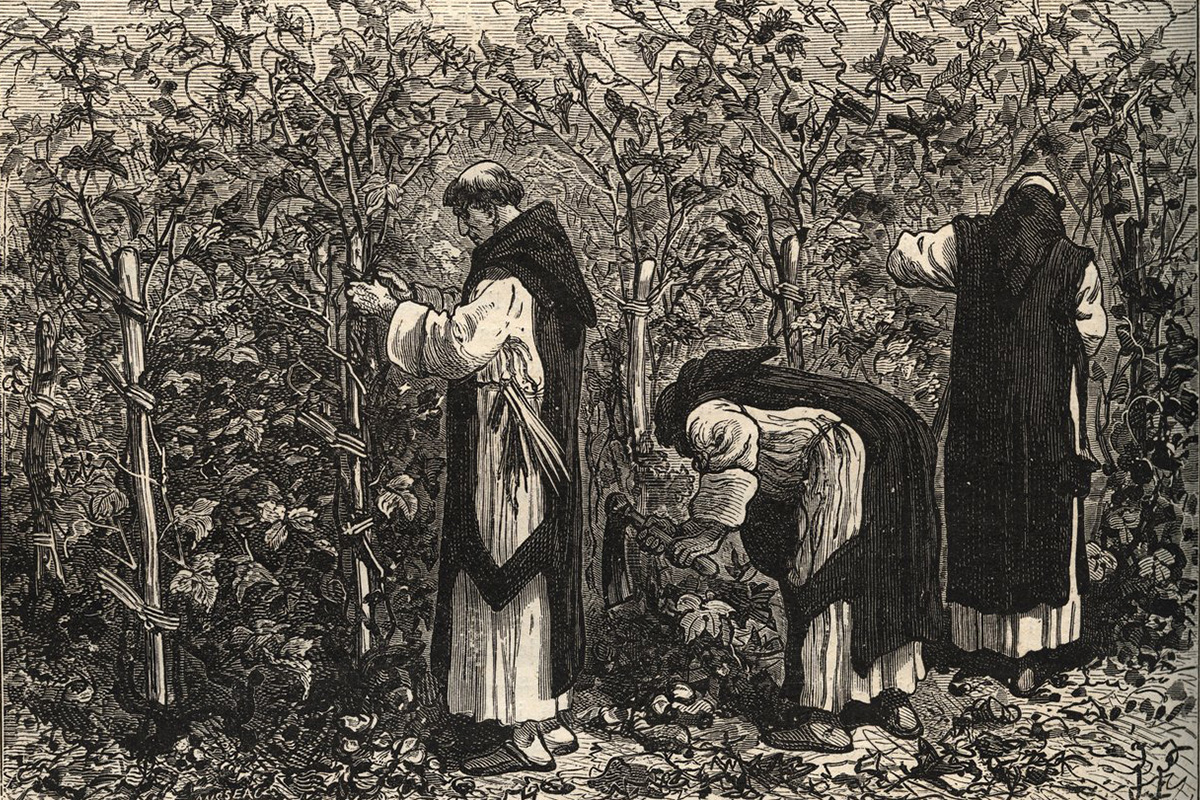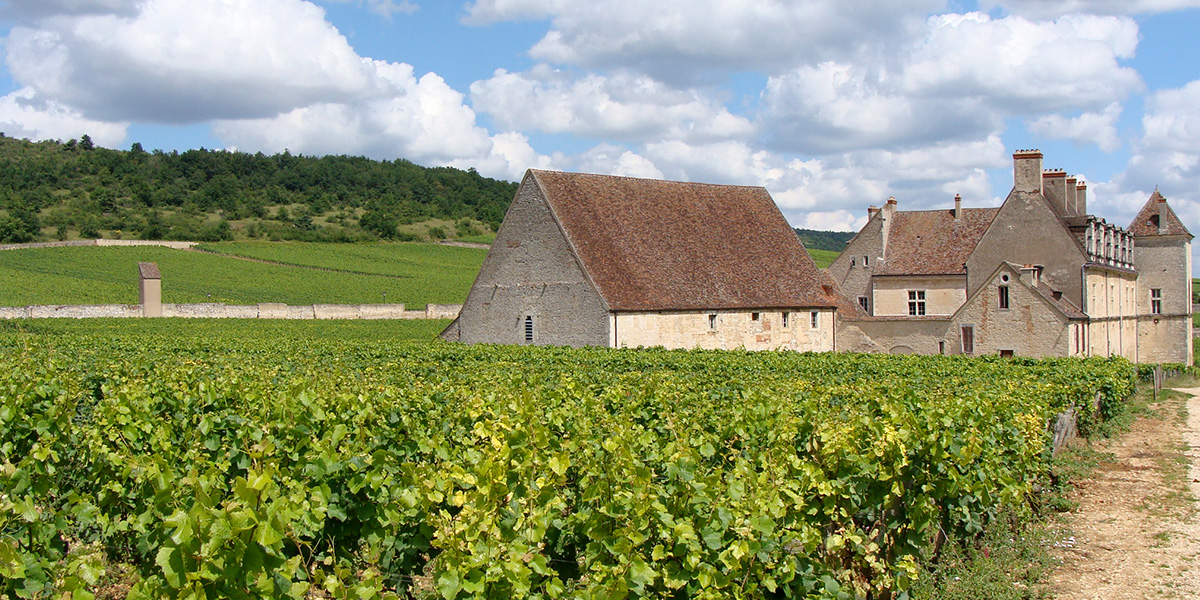View Articles by Category
Learn About The Monks of Burgundy and Their Influence on Wine

How the Monks of Burgundy Impacted the Development of Wines
Long before the famous Dukes of Burgundy made their mark on the region and its wines, a different group of wine enthusiasts populated the land, cultivated the vines and spread the word—both of God and of wine. The monks of Burgundy in the Middle Ages developed viticulture practices more than perhaps anyone else in history, and many of their favorite vineyards and plots are still in use today; you might have drunk wine from one of them! Many of them can be found here on BurgundyWine.com.
Across the whole of France during the Middle Ages, Christianity was growing, and with it the sacred symbolism that was key to it. One crucial part of this symbolism (representing the blood of Christ) was wine.
The very first signs of wine growing in Burgundy date right back to around 100 AD, with gods in some stone carvings depicted as having vines in their hands. Later writings also referenced yards of vines which had been abandoned, meaning that viticulture must have been somewhat established already. Vineyards were given as donations and gifts to some orders of the monks of Burgundy, for example the one given to the monastery at Beze – and today you can still drink this wine if you look for the label bearing the name of the Clos de Beze.
The local nobility, who would go on to dominate the history of this region in a revolution that would happen centuries later, often gifted land to religious communities in Burgundy. And on this expanse of land were often planted large vineyards. The abbey of Cîteaux, for example, (from which derives the cheese of the same name) established vineyards in the 12th century and, through centuries of free labor, laid the foundations of their reputation and understanding of the diversity of the Burgundian terroir (follow this link for more detail).

Notable Monks Throughout Burgundy History
In Macon, the Benedictine Monks there were amongst the first to undertake viticulture on a significant scale (did you know that the eponymous Dom Perignon was a Benedictine Monk who pioneered certain viticulture techniques, which is why nowadays some Champagne is named after him?) However, later it was the Cistercian and Cluniac Orders who were the two most prominent communities, holding land in the Burgundy regions known as Cote de Beaune and Cote de Nuits, as well as the Chalonnaise and Macon. Their wine growing activities were developed first and foremost to provide wine at the communion mass, but they were so good that the wines enabled them to make money—and a reputation—across Europe.
The monks of Burgundy had the time, the knowledge of the land, the dedication and the cool cellars under their stone abbeys to really develop the viticulture in this region, and we have much to thank them for. Perhaps their success is also down to the fact that they were not doing it for profit – a little like their faith, it was about learning, respect for the land, and finding transcendent beauty from natural things. It was under the stewardship of these monks that the idea of terroir truly came into being, and to this day the plots of land (climats) still exist in their thousands.
The monk, Bertin, was known for his love of wine. He had a vineyard that grew excellent grapes, and it is named after him. The wine produced from this vineyard is now known as Gevrey-Chambertin. The village of Gevrey, located in Côte d'Or just south of Dijon, added the name of its most revered vineyard, Chambertin, in 1847.
It is not just in France that religious communities and missionaries have played a significant role in wine making; you can find stories similar to the monks of Burgundy in Argentina as well as California, Spain and New Zealand.

Discover more about the History of Burgundy Wine at the Clos de Vougeot
Well worth a visit if you are in the Bourgogne region is the Chateau du Clos Vougeot and its wonderful wines, with its enormous wine press and fantastic tours and guided wine tastings. You can find the finest wines from Clos Vougeot on the BurgundyWine.com website and read more about the wines of Vougeot here. The name itself derives from that of the little river Vouge which runs through. The word ‘clos’ was used to denote a plot of land surrounded by a wall, initially to protect vines from wildlife, and each with their own distinct character.
Today, another brotherhood is based on the hallowed ground of the Clos de Vougeot—the Confrérie des Chevaliers du Tastevin. Since 1934, this group has promoted Burgundy wine and has over 12,000 Chevaliers worldwide.
Incidentally, the Clos de Vougeot should also be on the list of anyone visiting Burgundy, and must rank as one of the finest and most memorable sites to visit and perhaps taste a few wines. The small village of Vougeot, located in the Côte de Nuits region of Burgundy, is named after the little River Vouge. Despite being the smallest commune in the region, it boasts the largest Grand Cru plot, known as the Clos de Vougeot. This vineyard spans over 120 acres and is tended to by more than 50 producers, producing some of the very best wine. For anyone visiting Burgundy to experience wine, a visit to Clos de Vougeot is a must. There's a great website that can help visitors plan and book their Burgundy day trips.
Wine tasting at Clos de Vougeot is a remarkable experience. Enjoying Burgundy wine inside the great Chateau’s walls, surrounded by the huge barrels, presses, and centuries of history, is an unforgettable pilgrimage for wine enthusiasts. In Burgundy, after all, thanks to the Monks of Burgundy the past and the present live side by side, with both of their influences creating the Burgundy we know and love today.

The Dukes of Burgundy: the Next Chapter in Burgundy Wine's History
The other key figures we must mention when talking about the history of Burgundy and its wines are the Dukes of Burgundy, who came after the monks. Throughout the long history of Burgundy, religions, wars, and the nobility are intertwined with each other. For many centuries, the religious orders of the monks in France owned the land and took care of the vines around their Abbeys. Some of these Abbeys even gave names to certain foods including cheeses, such as Citeaux. Today, many of the most well-known and beloved wines come from vines on their plots, and some still carry their names. For example, ‘Gevrey Chambertin’ translates to 'the field of the monk Bertin'. Starting from the 14th century, the nobility gained more importance, and the well-known Dukes of Burgundy were the ones who owned and benefitted from the vineyards in the Bourgogne area. Wine, which was once considered a holy symbol of the blood of Christ, became a sign of wealth, class, and influence.
Elden Selection's Burgundy Wine Club is a unique opportunity for wine lovers to learn about the famous Burgundy region and its wine producers. Members receive four shipments every year, along with two specially selected wine glasses, and invitations to member-only virtual events in the US. Additionally, members have a chance to win a stay at our luxurious Burgundy manor house, Domaine de Cromey. To learn more about the Burgundy Wine Region, its producers, appellations, and terroir, visit the BurgundyWine.com blog.